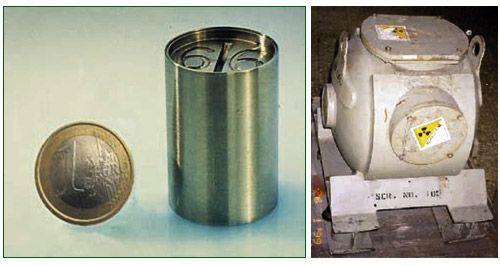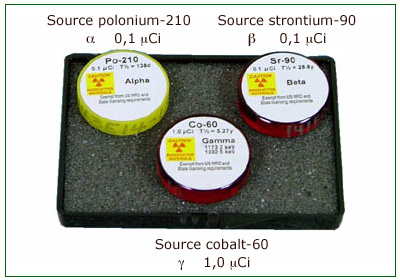Sealed sources and radioactive tracers: multiple applications

Sealed Sources
Sealed sources are designed to prevent the dispersal and contact of radioactive materials they contain. The sources are stored, when not in use, in containers called castles, to avoid unnecessary exposure to radiation. Small sealed source on the left and container on the right for storage and transport of a powerful radioactive source.
© ANDRA/IAEA
Minute quantities of radioactive atoms are used to meet the needs of medicine, industry or research, as radioactive sources or tracers. These radioelements that do not exist for most of them in a natural state are generally produced in specialized installations: small reactors designed for that purpose or, in the case of some very short-lived isotopes used in medicine in large hospitals, small accelerators installed permanently.
Among their quotable uses: the treatment of cancer, medical diagnostics, industrial irradiation, the non-destructive control, the control of many parameters and laboratory applications. For industrial irradiation and treatment of cancers, some sources are powerful.

Small laboratory sources
Samples of small laboratory sources marketed by an U.S. company to test the functioning of Geiger counters. A quantity of radionuclide, of required activity, is placed in a 3 mm deep hollow plastic disc, filled with epoxy glue that holds the radioactivity. The activities of the three sources displayed (alpha, beta and gamma) are around a microcurie (millionths of a curie), comparable to rhe human body natural radioactivity, that’s to say very low.
© imagescoI
These radioelements can cause an accidental exposure to radioactivity if precautions are not taken. Dispersal of these radionuclides when they present a danger because of their activity, the noxiousness of rays or the life of the radioisotope must be avoided.
That’s why the radioactive sources are usually sealed to prevent the dispersal of radioactive material. When they are not used, they are stored in a container, a “castle” in order to avoid unnecessary exposure to radiation.
The main radioprotection problem of radiation with radioactive sources is their large numbers, a consequence of their multiple applications. Thus, the Nuclear Safety Authority (ASN) must manage some 50,000 radioactive sources used in industry, research and medicine. Another problem is the end of life of these sources, which become waste managed by the National Agency for Radioactive Waste. In late 2002, the number of used sealed sources was estimated at about 140,000.
The tracers can be considered as radioactive sources that are not sealed. The quantities of radionuclides in question are much smaller and shorter lifetimes, allowing their dispersal. They are widely used in medical diagnosis.
The use of radioactive tracers incorporated into molecules is very common in biological research. They are thus a powerful tool of investigation in cell and molecular biology. The main radionuclide used as tracers are phosphorus 32 or 33, carbon 14, sulfur 35, chromium 51, iodine 125 and tritium. They are used as tracers and for calibration or instruction purposes.
A plethora of radioactive tracers are used in industrial processes to investigate the causes of problems or losses of performance, measure flow, controlling mixtures of materials, locate leaks in heat exchangers and piping. For example, the oil industry uses radioisotopes to identify leaks in its oil and gas pipelines.